The Consumer Electronics Association forecasts that the U.S. consumer electronics industry – in which photonics plays an enabling role – will generate $223 billion in wholesale revenue during 2015.
It’s a mixture of aesthetics, convenience and safety, along with a good measure of curiosity, that is driving photonics technology into our everyday lives. From smartphone gadgets, displays and virtual reality gaming to automotive sensors and wearable diagnostics, there is a scope for optics to enhance almost every aspect of the consumer’s world.
Consumer electronics (CE) products employ some cutting-edge optics, including semiconductors, optical fibers, LEDs, OLEDs, LCDs, IR imagers and sensors, and more. The top five product categories are smartphones, tablets, LCD TVs, laptops and gaming consoles, which are all products that rely heavily on advanced optical technology. Table 1 illustrates that these categories represent more than half of the total consumer electronics business in the U.S.
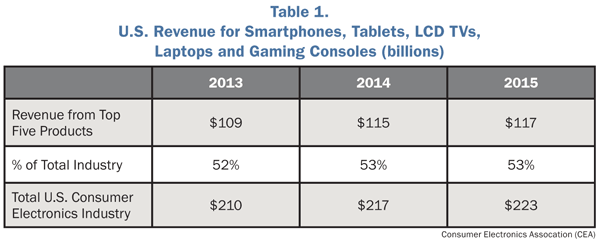
Photo courtesy of Consumer Electronics Assocation (CEA).
“These products all have eye-catching displays that are rapidly approaching the limits of visual acuity. Resolution, high dynamic range (HDR) and wide color gamut (WCG) are three display characteristics undergoing the most dramatic improvement,” said Brian Markwalter, senior vice president of research and standards at the Consumer Electronics Assocation (CEA) in Arlington, Va. “Consumers are snapping up 4K Ultra HDTVs with 3840 × 2160 resolution at a phenomenal rate.”
Right on the heels of the fourfold increase in resolution is the introduction of HDR technology, which promises a much greater range of brightness and shadow detail than is currently available. In the past, TVs were able to deliver around 35 percent of the color range that can be discerned by most viewers, but next-generation displays with WCG will be capable of displaying a broader range of colors and deeper hues that more closely reproduce natural colors.

Ultra HD technology at Samsung’s press conference during the 2015 International CES Press Day event. Photo courtesy of CES.
For manufacturers, breaking into the consumer world is all about satisfying the acronym SWaP-C. This means the product design must strike the right balance between size, weight, power and cost to push new and existing photonics into the general consumer market.
SWaP-C balance is critical to improvements under way in portable devices, such as smartphones and tablets. Power is hugely important in the devices, but as manufacturers explore new avenues, the balance shifts depending on intended application.
One example is OLED displays, which have had the highest impact in small form factor devices and are an enabling technology for flexible displays that are now on the market through bendable smartphones.
Consumers hot for IR
Twenty years ago, Flir Systems Inc. of Oregon was best known as a supplier of high-end thermal imaging systems for militaries and law enforcement agencies. But the thermal imaging pioneer is now breaking into brand-new territory; and the hope is that its IR cameras will become a routine feature of future portable consumer devices (e.g., smartphones, tablets, etc.).
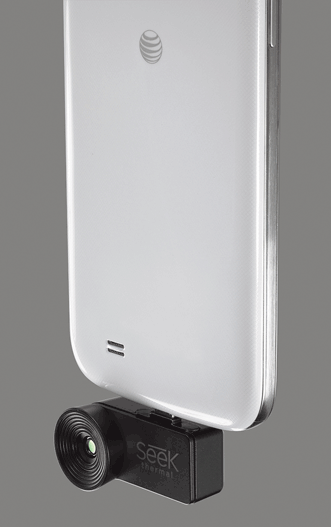
Thermal imaging add-ons to smartphones such as this Android phone are expected to reach sales of tens of thousands in 2015, according to a Yole Développement market report carried out in 2014. Photo courtesy of Seek Thermal.
Thermal imaging has a number of applications, ranging from personal safety to energy efficiency to surveillance. The problem was that size and cost limited the technology to military and security customers with big budgets. But like so many trends in high-volume electronics manufacturing, the cost to produce thermal imagers has steadily decreased, especially within the past 15 years.
“We knew that if we could reduce the size of imagers and the cost of production, we could eventually offer products at a price point that would appeal to mass consumer markets,” said Bill Terre, vice president and general manager of Flir OEM & Emerging Markets. “In the last decade, we’ve accomplished that. Steadily our imagers have become smaller, less expensive, while still remaining powerful.”
About 10 years ago, the company introduced a night-vision system for automobiles; it was soon followed by handheld cameras for recreational boaters, outdoor enthusiasts and thermographers. But with even the least expensive thermography cameras starting at just under $1000, the general consumer market remained elusive – until now.
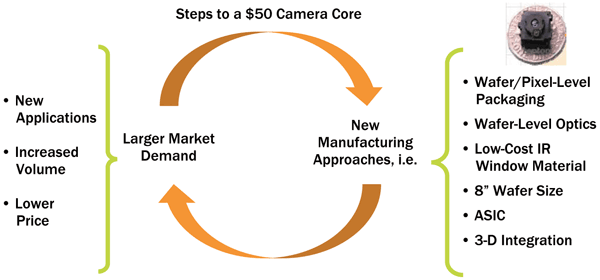
Photo courtesy of Yole Développement.
Thanks to a revolutionary design approach, Flir Systems developed a new class of thermal imager. The company built a high-volume uncooled long-wave IR (LWIR) sensor – dubbed Lepton –
that fits on a fingertip. Since it is uncooled, Lepton has few to no moving parts, making it especially rugged, shock-resistant and compact. Measuring
8.5 mm wide at its base, the camera weighs a scant 0.55 grams, consumes less than 150 mW of power, and offers a native resolution of 80 × 60 active pixels – enough to detect the heat signature of a person as far away as 100 feet.
“Who would have thought 10 years ago that smartphones would be the point-and-shoot camera of choice for the majority of consumers, or that they would be equipped with GPS technology once restricted to military use?” Terre said. “But that’s what’s happened, and we believe consumers’ reliance on mobile devices will only increase. This is why the Flir ONE is such an important entry-level product for us. At $249.99, Flir ONE is our first major product with the imaging capabilities and price point to appeal to the consumers in general.”

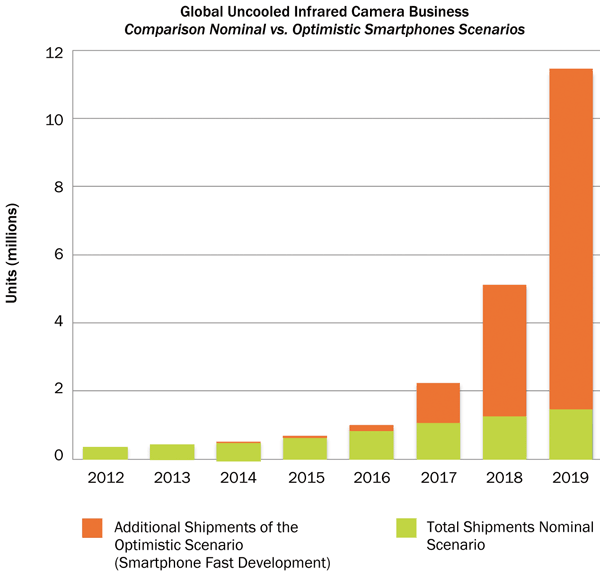
Photo courtesy of Yole Développement.
Even though consumer IR imaging is still in its infancy, it’s certainly generating a lot of excitement. Experts at market analyst Yole Développement of Lyon, France, predict sales already in the order of tens of thousands for this new type of consumer IR imaging product in 2015, according to its recent report, “Uncooled Infrared Imaging Technology and Market Trends,” 2014 edition.
“It should benefit from the novelty effect for at least one or two years,” said Pierre Cambou, activity leader for MEMS and Imaging. “In order for the trend to keep its momentum, it will be necessary that new-use cases come into play. We are relatively confident that this will happen.”

With applications in home improvement, personal safety, hunting and boating, and for first responders, Seek Thermal is optimistic about the future of consumer IR imaging. Photo courtesy of Seek Thermal.
And this indeed seems to be happening. Flir has already incorporated its microthermal camera into other products, including an IR imaging thermometer, pocket thermography camera and security camera.
“We are also making Lepton available as an OEM component to product designers and hobbyists who want to explore ways of incorporating thermal imaging into new and existing products, such as miniature unmanned aerial vehicles (UAVs), home automation controls and industrial sensors,” Terre said.
Yole Développement is also confirming this emerging trend and monitoring with interest the IR technology being employed in personal robotics applications – typically personal drones and security robots.

Drones and other unmanned aerial vehicles are taking off at the Unmanned Systems Marketplace at the Consumer Electronics Show. Photo courtesy of CES.
Following Flir’s release in 2014, a new startup, Seek Thermal Inc., headquartered in Santa Barbara, Calif., released its own plug-in thermal camera for IOS and Android smartphones. The company was founded by Bill Parrish and Tim Fitzgibbons, pioneers in the thermal industry, who, after working in the field for years, set out to develop a thermal camera accessible to consumers.
“Since launching the Seek thermal camera this year, we have been hard at work on new technology and improved features,” Fitzgibbons said. “In fact, we just launched the Seek XR, an extended-range version of the original camera that allows users to view objects at close range, or at distances of up to 2000 feet. This new camera follows specific feedback we’ve received from gun experts, boating enthusiasts, law enforcement and early adopters of thermal imaging.”
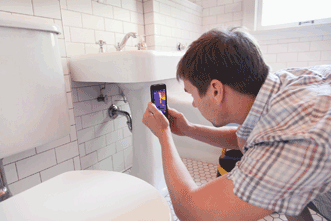
Photo courtesy of Seek Thermal.
Smartphones to smart homes, vehicles to games
With the digitization and sensorization of our lives, consumers now expect to know the status (and have full control) of everyday objects that are both nearby and remote. This trend is never so well-illustrated than in the rise of the smart home market.
“The CE industry drives the volume necessary to recover R&D investment,” said the CEA’s Markwalter. “As such, trends in consumer electronics and photonics are inextricably linked. A case in point is the smart home market segment of the Internet of Things.”
Lighting up smart homes are LED smart lights, such as the Philips HUE and Belkin’s WeMo, which are mobile Internet-enabled LED lights from lighting specialists Osram GmbH and TCP International Holdings Inc. that offer unprecedented control over color temperature, brightness, and individual and group switching. Similarly, image sensors connected to the Internet are enabling home security and communications at prices unachievable until recently.
Visual experiences will continue to motivate consumers, and crucially, it is the photonics – both in image capture and image display – that keeps driving many innovative consumer breakthroughs, according to the CEA.
Virtual reality (VR) and augmented reality hold great promise. For example, VR implemented by Oculus VR Inc. (based in Menlo Park, Calif.) in its Crystal Cove developer kit uses image sensing to track head motion and keep the displayed image tightly synchronized with gaze direction.
The move toward autonomous vehicles will also require significant development in sensor platforms. This not only relates to driverless cars, but also to the rise in drones and personal robotics.
“Cars will require multispectral sensing and imaging to manage the complex roadway environment. Even headlights will become smarter with steerable LEDs that can avoid blinding oncoming drivers,” Markwalter said. “Drones, or unmanned aerial vehicles, are poised to make significant commercial contributions. These systems will almost universally have cameras for navigation, videography and inspection. Lightweight, high-quality cameras with stabilize mounts will be in demand.”
Another emerging trend noticed by Yole Développement is the consumer-driven demand in wearable diagnostics, such as wristwatches that monitor heart rate while exercising. New generation devices are expected to incorporate near-infrared light sources to enable them to perform a diagnostic test noninvasively, with test results potentially wirelessly transmitted to the user’s personal physician.